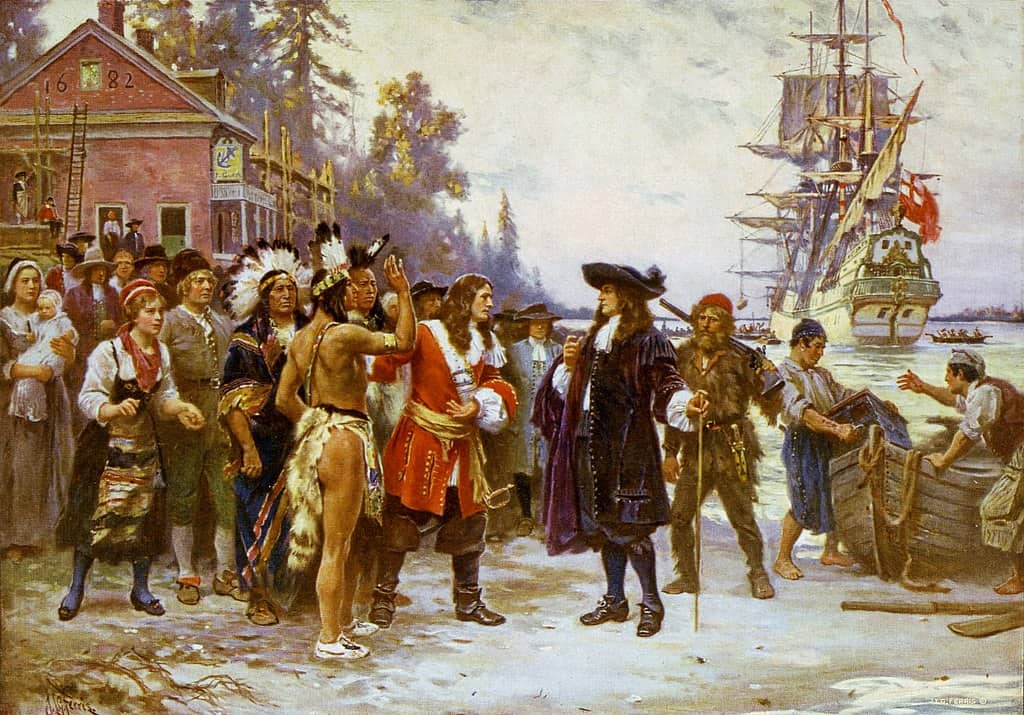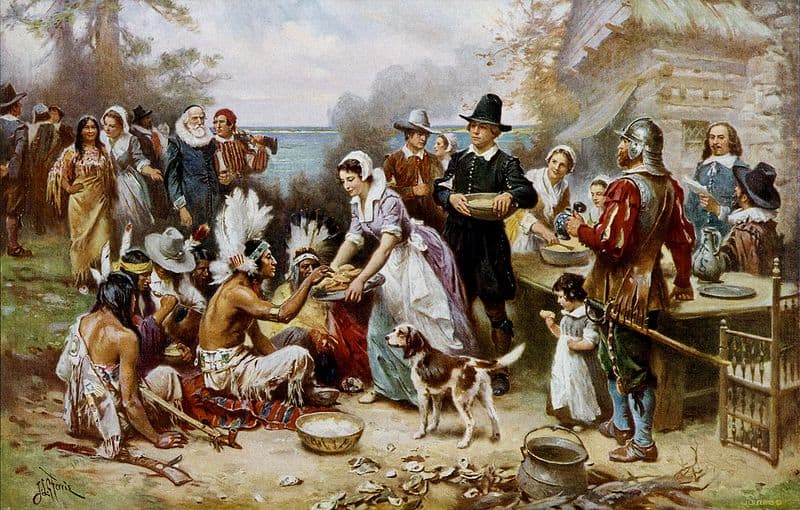
The First Thanksgiving (1621) is an oil painting by artist Jean Leon Gerome Ferris. It is a one of a collection of paintings titled ‘The Pageant of a Nation.’ Published in 1932, Pageant of a Nation is a collection presenting romanticized depictions of significant moments of American history. This painting represents what the artist would like its audience to view as the first Thanksgiving: a harmonious coming together of Indigenous Peoples and White Europeans.

This image is also part of the collection by artist Jean Leon Gerome Ferris. It is titled The Landing of William Pen (1682.) It depicts William Penn, founder of the Province of Pennsylvania, arriving on the shores of the New World to be greeted by its current inhabitants. Take note that the Native Peoples depicted in this painting are wearing traditional clothing of Great Plains tribes. Is Pennsylvania near the Great Plains?
Student Questions
- What details do you notice in these paintings and what is the story they tell? How are the white people conveyed? The Native people?
- What does this story tell us about the American national identity and self image?
- What ideas about our national identity do the paintings reinforce?
- Bonus question! What does the name for the collection, Pageantry of a Nation, resemble? Why might this be significant?
Instructional Goals and Model Answers
Students will be able to examine paintings critically, determining the accuracy of historical representation. Students will be able to identify symbols within the paintings that provide insight towards the American self identity at the time of these paintings. Think critically about how these values continue to be presented in American culture.
- The most notable thing about the first painting is the position of the characters within. The Native people are seated at the feet of the white settlers, who are providing them with food. The Native people are positioned at the same level as the dog and the child in the foreground. The food, setting, and clothing in both pictures are historically inaccurate, presenting European foods and structures as opposed to those that would have actually been there.
- These paintings are the ultimate representation of American Imperialism. The White people in the photos are ‘saving’ the Native peoples, who are positioned below them, implying that they are closer to the status of a dog than of the white individuals. The Natives are depicted as thankful for the kindness of these settlers. This romanticization of American settlers as ‘helping’ is the same propaganda used throughout history to justify the subjugation of non-white peoples.
- Americans saw themselves as heroes. They came to a savage land to rescue it. Instead they decimated its native population. By reimagining the impact of settlers, American Identity can remain one that is pure and beautiful. It can be imagined as a peaceful and joyous time, reinforcing the notions of American superiority.


A great pair of images that represent our idealized visions of the past. Students would be able to answer your questions with a close reading of the images without needing a lot of background knowledge. They might need a bit of help with Plains Indians dress and brick building. But the central task is well within their reach.
This lesson would be a great intro to looking at both the history of American imperialism and the role of “history” in shaping our modern world views. Well done!
PS/ I especially like the title for post
Lucy, I love that you pointed out the type of dress the Native Americans are wearing in the painting. What an amazing detail that could so easily be overlooked!
Your “bonus” question is also great. I would love to hear students talk through the collection title!!